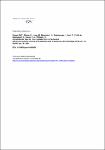Acinetobacter equi sp. nov., isolated from horse faeces
Poppel, Marie T.
Skiebe, Evelyn
Laue, Michael
Bergmann, Holger
Ebersberger, Ingo
Garn, Thomas
Fruth, Angelika
Baumgardt, Sandra
Busse, Hans-Jürgen
Wilharm, Gottfried
The taxonomic position of five strains isolated from horse faeces, and which shared identical 16S rRNA gene sequences, were studied. Cells of all isolates are Gram-stain-negative, obligately aerobic and have a rod-shaped appearance. The strains show highest 16S rRNA gene sequence similarities to Acinetobacter lwoffii (98.3 %), Acinetobacter haemolyticus (98.0 %), Acienetobacter johnsonii (97.9 %) and Acinetobacter brisouii (97.9 %). Whole-genome sequencing of strain 114T and phylogeny reconstruction based on a core set of 1061 Acinetobacter genes indicated that A. bouvetii CIP 107468T was the closest relative among species of the genus Acinetobacter for which whole genome sequences are available. The genomic DNA G+C content of strain 114T is 34.9 mol%, which is lower than any other value reported for the genus Acinetobacter. The predominant polyamine is 1,3-diaminopropane, which is typical for the genus Acinetobacter. The most abundant fatty acids are C16 : 1ω7c and/or iso-C15 : 0 2-OH (36 %) and C16 : 0 (28 %). The proportion of C18 : 1ω9c (7 %) is distinctively low compared to most species of the genus. The major ubiquinone of strain 114T is Q-9. Microscopic studies revealed the presence of pili and the absence of flagella. The capability of all five strains to utilize l-arabinose and gentisate as well as their lack of growth at temperatures of 41 °C and above provide sufficient criteria to distinguish the isolates from all species of the genus Acinetobacter with validly published names. Based on these combined data, the five isolates represent a novel species of the genus Acinetobacter, for which the name Acinetobacter equi sp. nov. is proposed. The type strain is 114T ( = DSM 27228T = CCUG 65204T).
Dateien zu dieser Publikation
Keine Lizenzangabe

